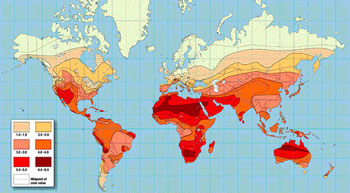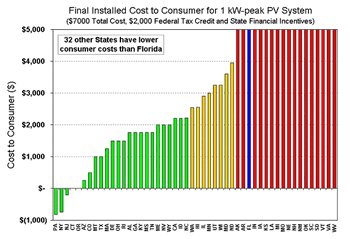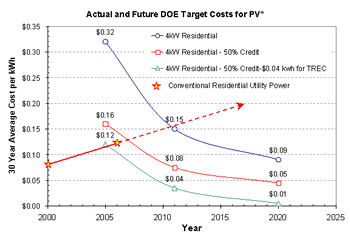If Florida is the “Sunshine State,” how come we don’t
use more solar energy than the Golden State (California) or the Garden
State (New Jersey)? Are we really the Sunshine State?
We asked FSEC’s Jennifer Szaro to give us some idea how we
really measure up in terms of the attractiveness of our state for
the development of a sustainable solar market. She took a look
at world solar resource maps and noted that Florida ranks tenth in
the continental U.S. for solar availability, so it clearly is not
just the amount of sunshine that dictates the market.
The overall U.S. market for solar energy products and systems is
far behind Japan and Germany (both of which have lower solar availability
than Florida). Moreover, several states (including northern
ones like New York, New Jersey, and Pennsylvania, all of which have
lower solar availability than Florida), have done a far better job
of installing solar capacity than Florida.

World Solar Resource map illustrates average daily solar insolation
in Watts/square meter.
Research conducted through the National Renewable Energy Laboratory
(NREL) signifies that Florida currently ranks 11th in the country
for solar market attractiveness. This ranking is based on a
number of factors including energy policies, amount and quality of
solar resources, utility rates and customer load match.
So why aren’t we seeing more interest in buying solar energy
products and systems in Florida? The main issue appears to be
not the solar resource we have in our state, but the level of financial
incentives compared with the rest of the country. Florida trails
much of the country in our solar incentive policies, meaning that
solar energy costs the average residential consumer more in our state
than it does in more than two-thirds of the other states. As shown
in the figure below, which includes the new federal tax credits, many
residential consumers around the country can purchase the first kW
of photovoltaics for their homes at half the cost of what consumers
in Florida pay!

The next figure shows the cost equivalence in dollars per kWh of
electricity generated from 4-kW photovoltaic systems installed on
residential rooftops throughout the U.S. as determined by the U.S.
DOE. The 2005 actual year cost equivalence of $0.32 per kWh
appears at first to be much higher than the $0.12 per kWh that many
of us in Florida pay to our utilities. But if the state of
Florida were to provide a wrap-around rebate that augments the federal
tax credit at 50 percent of the purchase price, this $0.32 per kWh
is reduced to $0.16. If the tradable renewable energy credits
(TRECs) for this electricity are sold on the Chicago Mercantile exchange
at $0.04 per kWh, then the cost is reduced to $0.12 per kWh – the
same amount that we are paying today for electricity coming out of
the wall. Future DOE cost projections show the cost of a 4-kW
system without financial incentives decreasing from a present value
of $0.32 per kWh to $0.09 per kWh by 2020.
This decrease in cost is due to several factors including improvements
in efficiency, endurance of the invertors and increased total markets. We
must remember that the cost of the solar photovoltaic power plant
is high today, but the cost of the fuel is free today and will be
forever! The solar fuel also does not pollute! Can we
say either of these for coal and natural gas?
We remind you that you pay $0.12 kWh from the utility today, but
you paid $0.10 kWh last year, a 20 percent increase and $0.075 in
2000. If one assumes that the cost of electricity from Florida
utilities only goes up by 3 percent per year, by 2010 we will pay
$0.135 kWh and by 2020 $0.18 kWh. So with no incentives at all,
in 2020 the photovoltaics on your roof will cost half of what you
will be paying the utility!
It should be noted that if we began to build nuclear power
plants today to help with our future energy needs, those plants will
not be producing power until 2020.

The bottom line is that we do, in fact, have a significant solar
resource here and we do have many favorable conditions for economic
success of a thriving solar industry. Photovoltaics on our roofs
lets Florida become energy independent. Financial incentives
may be the only missing piece to truly making us the “Sunshine
State.”
Return to the Energy Chronicle homepage
